Who will be a driving force for consumer spending on the recovery track of economy?
At long last, the Japanese economy is taking a favorable turn. In terms of consumer sentiment, however, there is still a prevailing mood of cutting cost of living commodities including foods. What is the future course of consumption on the recovery track of business condition and stock prices? Having experienced a number of economic recessions, consumers have become more likely to save money in order to overcome the harsh economic conditions such as declining income and uncertain employment. They are saving money not because of the helplessness. Consumers cast keen eyes on whether the quality of product or service has a good value for money and select only what they find worth for the price. Today, the elders and the wealthy people are leading personal consumption. Following them are working women, who are expected to grow in number. Supporting women who have a job may lead to growing consumption and economic recovery.

Keiko Wakahara Columnist
Table of contents
Upturn in consumer spending
Monthly consumer confidence survey (Cabinet Office) and Household consumption index (Ministry of Internal Affairs and Communications) showed an upturn in consumer spending in March and April. In addition, it is pointed out that March saw a recovery in sales of women’s apparel at department stores and an increase in sales of flat-screen TVs.
◆Chart 1: Consumer attitude index (households)
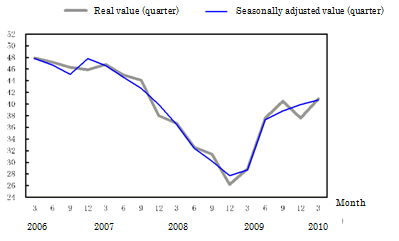
Source: Household spending survey by Statistics Bureau, Ministry of Internal Affairs and Communications
Baby boomers and high-income earners play a leading role in consumption
Who supports such consumption? It was senior citizen that fueled personal spending in 2009. Behind the figures, the elderly who have already repaid housing loans have less debt than the young who still have to pay them. In 2009, households of the middle-aged and the elderly purchased more flat-screen TVs than other age groups. (See chart 2 and 3.)
Chart 2: The amount of household spending by age bracket of householder and real year-on-year rate
(Working-class households which consist of two people or more) -2009-
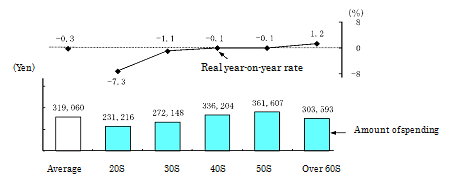
Source: Household spending survey by Statistics Bureau, Ministry of Internal Affairs and Communications
Chart 3: The average cost for purchasing TV by age bracket of householder (including those who didn’t buy TV) -2009-
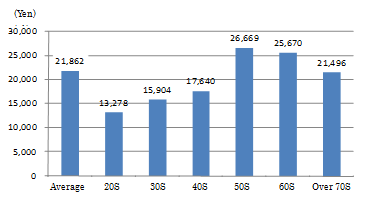
Source: Household spending survey by Statistics Bureau, Ministry of Internal Affairs and Communications
Future trend of consumption
Japan has seen a number of recessions*1. Having faced such economic difficulties, Japanese consumers have acquired matured behavior. That is also the results of corporate efforts, such as offering value-added products or services and setting up new types of discount stores or shops selling high quality goods at lower prices than others.
According to a recent survey, people tend to develop a discerning eye for something worthwhile rather than to get cheap things. (See chart 4-1 and 4-2.) Furthermore, there are a growing number of people who gather information before buying something or are interested in the word of mouth from users in order to assess whether the quality is worth money.
◆Chart 4-1 Basic values of consumption
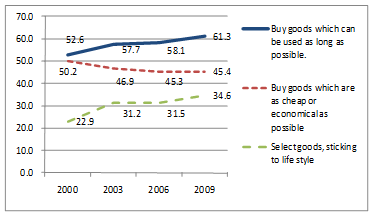
◆Chart 4-2 Growing sensitivity to information
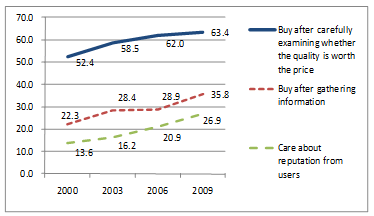
Source: Questionnaire to 10,000 ordinary citizens (in 2000, 2003, 2006 and 2009) conducted by Nomura Research Institute
Who has great potential to consume?
In recent years, working women have attracted attention as big spenders. According to a survey in which a private institution asked 10,000 working women, they are more willing to spend money than full-time homemakers. The data covers both married and unmarried women who work as self-employed worker, temporary worker, contract employee, regular employee, civil servant or managerial staff. The results show that over the last year, working women have spent twice as much on clothing, hobbies and leisure activities as full-time homemakers. The unmarried have spent more than the married, and women who have no kids have spent more than mothers.
Chart 5-1 and 2: Consumption expenditure
◆ Clothing costs over the last year
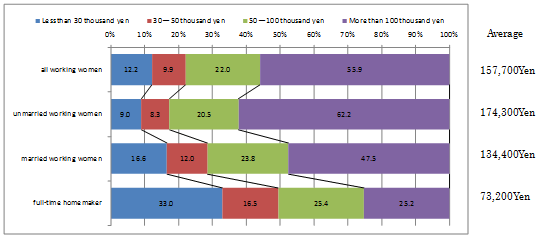
◆ Monthly costs on hobbies and leisure activities over the last year
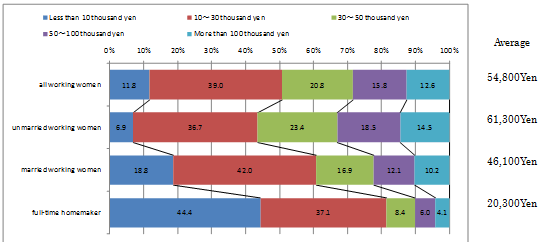
Source: “Markets developed by working women” compiled in March 2010 by Research Institute of Industry and Regional Economy, Nihon Keizai Shimbun Inc.
What motivation do women have for working? According to the annual White Paper on Women’s Labor for 2009 released by the Ministry of Health, Labour, and Welfare, the ratio of married women in their late 20s and their early 30s who are willing to work (labor participation ratio) *2 was about 53% in 2009. This means that women’s labor participation ratio has risen by about 9 points from a decade ago. Since the salary of men has continued to decline due to economic recession, the number of women who have started to work has increased. In a so-called “M-Shape curve” *3 which shows women’s labor force ratio by age, the bottom has been picked up .
Chart 6: Women’s labor participation ratio by age (for unmarried women)
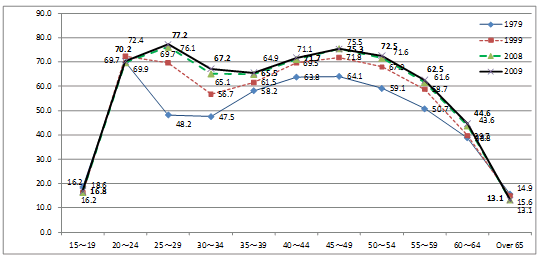
Source: “Labor Force Survey” by Statistics Bureau, Ministry of Internal Affairs and Communications
Having experienced a number of economic recessions, women have come to adopt a reasonable attitude on consuming. More and more such working women are expected to be more eager to consume than ever before.
At the present, it is senior citizens with less debt and high-income earners who play as drivers for consumer spending. Beside them, more attention should be given to the working women as leading consumers. Improving the working environment for women may lead to a growth of consumption and economic recovery in Japan. On June 30th, the amended “Child Care and Family Care Leave Act” *4 came into effect. The law may be regarded as one of the most effective measures to expand consumption through encouraging people to maintain their work-life balance.
